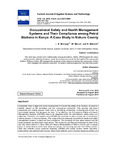Occupational Safety and Health Management Systems and Their Compliance among Petrol Stations in Kenya: A Case Study in Nakuru County

View/
Date
2019-08-22Author
Mutungi, J. K.
Moturi, W .
Makindi, Stanley Maingi
Metadata
Show full item recordAbstract
Companies have a legal and social responsibility to ensure the safety of its workers, all persons lawfully present at the workplace and the surrounding community. This requires laid down procedures and routing process which aims at identifying, eliminating, minimizing and control the work-related hazards and decrease the risks. To be effective, the Occupational Safety and Health Management Systems (OSHMS) need to be integrated within the organization’s safety policy and objectives. Therefore, this explains why OSHMS has continued to play a pivotal role in the decision making process in most companies. This study aimed at assessing occupational health and safety management systems in place and their compliance. The sampling unit was petrol stations and the study employed use descriptive study design. The purposive sampling was employed to select thirty two (32) petrol stations in Njoro Molo and Nakuru Municipalities of Nakuru County with a special focus on petrol stations which have dispenser pumps, car servicing bay and Front Office section. Data was collected using purposive sampling, stratified and simple random where interviews, observations and questionnaire survey. Descriptive statistics which involved frequency tables and percentages was used to analyze the data. The findings of this study shows that more than half of the petrol stations lacked defined Occupational Safety and Management systems. There is need of Occupational Safety and Health Management System to be integrated within petrol stations policy in order to reduce the operations mistakes, costs of reducing problems and level of risks while ensuring that they comply with laws and regulations.
